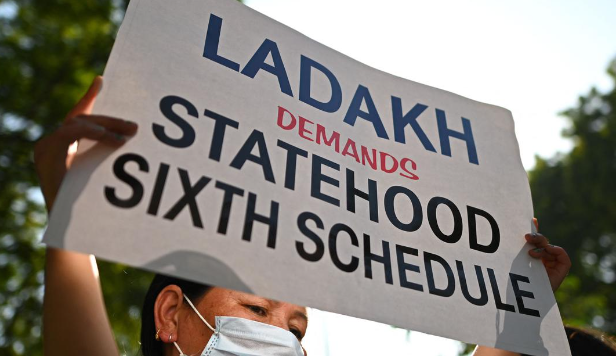What is the Sixth Schedule Demand of Ladakh?
Ladakh should be added to the Sixth Schedule of the Indian Constitution. This demand has gained a lot of support in recent years. Many groups in Ladakh have been pushing for this, especially since the area became a Union Territory in August 2019 when Article 370 was revoked and local government was given more freedom.
What is the Sixth Schedule?
The Sixth Schedule lists parts of the Indian Constitution that allow tribal places in Assam, Meghalaya, Tripura, and Mizoram to be managed in a way that protects their rights. One of these rules is the development of Autonomous District Councils (ADCs), which can make laws about things like land, forests, and agriculture. These councils can also set up village courts to settle small disagreements between tribes.
Why does Ladakh demand Sixth Schedule Inclusion?
Many of the people who live in Ladakh are from different tribe groups. For example, most of the people in Leh are Buddhist, and most of the people in Kargil are Shia Muslims. People who work for activists and community leaders say that adding these tribes to the Sixth Schedule will help protect and support their unique social practices and cultural heritage. Also, they would be able to have their own government, which would give them more power to deal with local problems, similar to what tribal areas in other parts of India have access to.
Potential Impact of Sixth Schedule in Ladakh
It is expected that the Autonomous District Councils would play a key part in local government if Ladakh is added to the Sixth Schedule. This freedom would let policies be made that protect ethnic identities, encourage growth based on local needs, and handle resources in a way that doesn’t harm the environment. People in the area would probably also feel less worried about how outside impacts and migration will change their culture and traditions.
More About tribal status
- Tribal communities are often thought of as primitive, but many of them have complicated social structures and a lot of cultural traditions.
- The Constitution of India recognizes India’s Scheduled Tribes as special groups that need extra help because of their unique social and economic situation.
- Tribal autonomy in the U.S. lets tribes run their own lands without interference from other groups.
- The Sentinelese people who live on North Sentinel Island are one of the last groups of people in the world who have not been touched.
- Because of the land divisions that began in the 1980s, Brazil’s constitution honours tribal land rights.
- The Declaration on the Rights of Indigenous Peoples was made by the UN in 2007 to protect tribal culture and autonomy.
- Taiwan’s native tribes have been there for a long time, but they have only been given official status in the last few decades.
- The Maasai people in East Africa are known for living a semi-nomadic life, which is largely shaped by land limits set by the government.
- New Zealand’s Treaty of Waitangi, which was made in 1840, is one of the most important documents that recognizes Maori rights.
- Since 1989, the Sami people in Norway have had their own government to protect their rights to land and culture.
Month: Current Affairs - May, 2024
Category: India Nation & States Current Affairs • States Current Affairs



